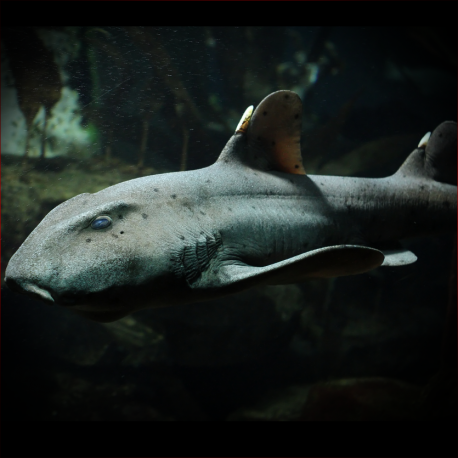More info
Datasheet
| Minimum Tank Size | 1890 litres / 499.29 US gallons |
| Maximum Size | 121.9cm / 47.99inches |
| Reef Compatible | No |
| Temperament | Aggressive |
| Care Description | Expert Only |
| Specific Gravity | 1.020-1.025 |
| Carbonate Hardness | 8-12 |
| pH | 8.1-8.4 |
General Description
The Horn Shark, scientifically known as Heterodontus francisci, is easily identified by its pointy teeth at the front of its jaws for catching prey and molar-like teeth at the back for crushing hard-shelled invertebrates. Sporting a tan body with black spots and a yellowish underbelly, this shark also boasts spines in front of each dorsal fin. Typically growing up to 4 feet long, with females slightly smaller, these sharks are primarily nocturnal hunters that camouflage themselves during the day among rocks or crevices.
Aquarium Suitability (Expert Only)
The Horn Shark is deemed suitable only for expert aquarists due to its aggressive nature and specific care requirements. Requiring a tank size of 500 gallons or more, this carnivorous shark demands meticulous attention to ensure its well-being in captivity.
Care and Hardiness
Due to its aggressive temperament, the Horn Shark necessitates an experienced keeper's supervision to thrive in a home aquarium. Maintaining stable water conditions with a pH range of 8.1-8.4, a dKH of 8-12, and a salinity level between 1.020-1.025 is crucial to their well-being.
Reef Suitability
The Horn Shark is not considered reef-compatible due to its predatory behavior. It may pose a threat to smaller tank mates and invertebrates typically found in reef environments.
Aquarium Setup
Creating a suitable environment for a Horn Shark involves providing ample hiding spaces like rocks or crevices to mimic its natural habitat. Installing robust filtration systems and ensuring enough swimming space within a tank of at least 1890 liters is essential for their well-being.
Behaviour
Known for their aggressive nature, Horn Sharks are carnivorous predators that require ample space to roam and hide. They tend to be more active during the night, utilizing their strong pectoral fins to crawl along rocks in search of prey.
Feeding and Diet
Feeding primarily on crustaceans, sea urchins, small fishes, and mollusks, the Horn Shark should be offered a varied diet in captivity to ensure proper nutrition. Their diet should include foods that help replicate their natural feeding habits.
Habitat and Distribution
In the wild, Horn Sharks are commonly found along the sea floor, camouflaging themselves to ambush prey. They are native to the eastern Pacific Ocean, ranging from California to the Gulf of California.

